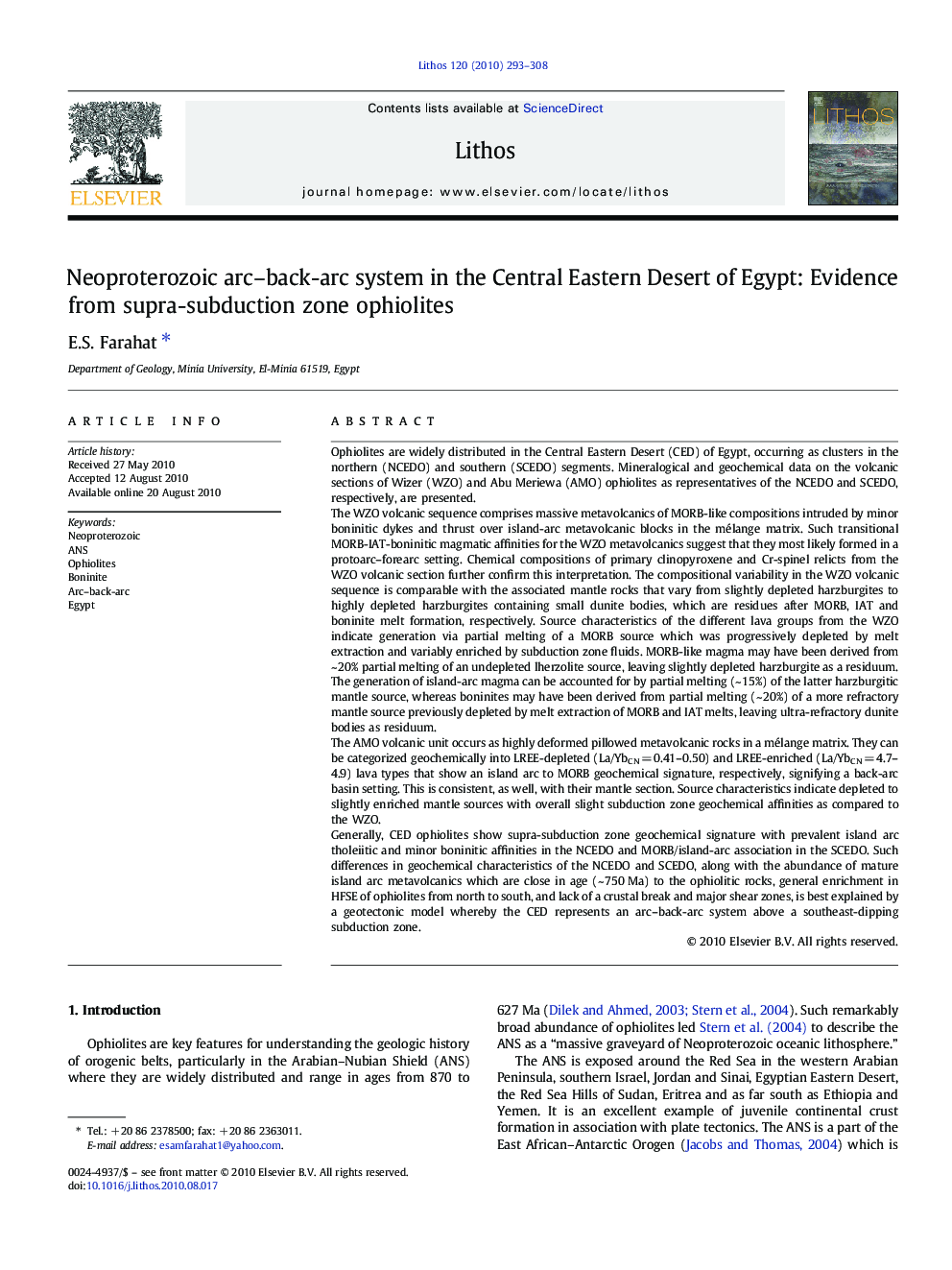| کد مقاله | کد نشریه | سال انتشار | مقاله انگلیسی | نسخه تمام متن |
|---|---|---|---|---|
| 4716848 | 1638726 | 2010 | 16 صفحه PDF | دانلود رایگان |

Ophiolites are widely distributed in the Central Eastern Desert (CED) of Egypt, occurring as clusters in the northern (NCEDO) and southern (SCEDO) segments. Mineralogical and geochemical data on the volcanic sections of Wizer (WZO) and Abu Meriewa (AMO) ophiolites as representatives of the NCEDO and SCEDO, respectively, are presented.The WZO volcanic sequence comprises massive metavolcanics of MORB-like compositions intruded by minor boninitic dykes and thrust over island-arc metavolcanic blocks in the mélange matrix. Such transitional MORB-IAT-boninitic magmatic affinities for the WZO metavolcanics suggest that they most likely formed in a protoarc–forearc setting. Chemical compositions of primary clinopyroxene and Cr-spinel relicts from the WZO volcanic section further confirm this interpretation. The compositional variability in the WZO volcanic sequence is comparable with the associated mantle rocks that vary from slightly depleted harzburgites to highly depleted harzburgites containing small dunite bodies, which are residues after MORB, IAT and boninite melt formation, respectively. Source characteristics of the different lava groups from the WZO indicate generation via partial melting of a MORB source which was progressively depleted by melt extraction and variably enriched by subduction zone fluids. MORB-like magma may have been derived from ~ 20% partial melting of an undepleted lherzolite source, leaving slightly depleted harzburgite as a residuum. The generation of island-arc magma can be accounted for by partial melting (~ 15%) of the latter harzburgitic mantle source, whereas boninites may have been derived from partial melting (~ 20%) of a more refractory mantle source previously depleted by melt extraction of MORB and IAT melts, leaving ultra-refractory dunite bodies as residuum.The AMO volcanic unit occurs as highly deformed pillowed metavolcanic rocks in a mélange matrix. They can be categorized geochemically into LREE-depleted (La/YbCN = 0.41–0.50) and LREE-enriched (La/YbCN = 4.7–4.9) lava types that show an island arc to MORB geochemical signature, respectively, signifying a back-arc basin setting. This is consistent, as well, with their mantle section. Source characteristics indicate depleted to slightly enriched mantle sources with overall slight subduction zone geochemical affinities as compared to the WZO.Generally, CED ophiolites show supra-subduction zone geochemical signature with prevalent island arc tholeiitic and minor boninitic affinities in the NCEDO and MORB/island-arc association in the SCEDO. Such differences in geochemical characteristics of the NCEDO and SCEDO, along with the abundance of mature island arc metavolcanics which are close in age (~ 750 Ma) to the ophiolitic rocks, general enrichment in HFSE of ophiolites from north to south, and lack of a crustal break and major shear zones, is best explained by a geotectonic model whereby the CED represents an arc–back-arc system above a southeast-dipping subduction zone.
Research Highlights
► Ophiolites in the Central Eastern Desert (CED) of Egypt cluster in its northern and southern parts.
► CED ophiolites show more IAT/boninitic affinities in the north and MORB/island arc in the south.
► The CED most likely represents an arc–back-arc system above a southeast-dipping subduction zone.
Journal: Lithos - Volume 120, Issues 3–4, December 2010, Pages 293–308